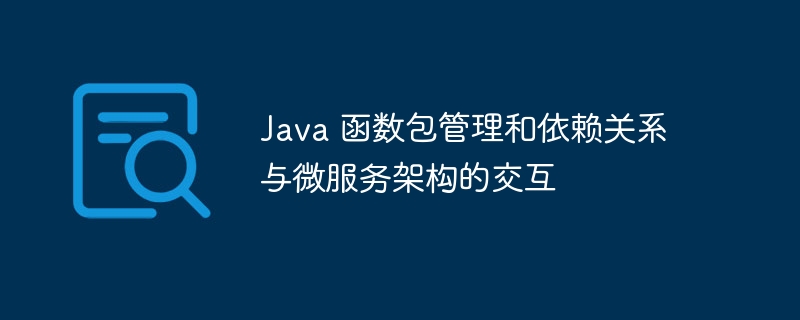 Java
Java
 javaTutorial
javaTutorial
 Java function package management and dependency interaction with microservice architecture
Java function package management and dependency interaction with microservice architecture
Java function package management and dependency interaction with microservice architecture
In a microservices architecture, Java function package management and dependencies are critical to building maintainable and scalable systems. Maven, a package manager for Java, facilitates microservice development through features such as dependency management, automated builds, and reproducibility. This article demonstrates the application of Maven in a microservice architecture composed of user, order and product microservices through a practical case. Each microservice has its own dependency management and dependency block, ensuring the compatibility and reliability of the microservice. Maintainability.

Interaction of Java function package management and dependencies with microservice architecture
In microservice architecture, function package management and Dependencies are critical to building maintainable and scalable systems. This article will explore the application of Java function package manager Maven in microservice architecture and provide a practical case.
Introduction to Maven
Maven is the leading package management tool for Java, which allows developers to declare project dependencies, download and manage them from a central or private repository these dependencies. Maven facilitates microservices development through the following features:
- Dependency Management: Maven allows developers to define dependencies for each microservice, ensuring that all microservices use compatible versions.
- Automated build: Maven provides a set of commands to build, test and package microservices, simplifying the development process.
- Repeatability: Maven ensures that builds of microservices are repeatable, regardless of which developer builds on which platform.
Maven’s practical case in microservice architecture
Consider a microservice architecture composed of user, order and product microservices. Each microservice has its own set of dependencies. The diagram below shows how these dependencies are declared and managed using Maven.
<!-- user 微服务 -->
<dependencyManagement>
<dependencies>
<dependency>
<groupId>com.example</groupId>
<artifactId>user-api</artifactId>
<version>1.0.0</version>
</dependency>
</dependencies>
</dependencyManagement>
<dependencies>
<dependency>
<groupId>com.example</groupId>
<artifactId>user-implementation</artifactId>
<version>1.0.0</version>
</dependency>
</dependencies>
<!-- order 微服务 -->
<dependencyManagement>
<dependencies>
<dependency>
<groupId>com.example</groupId>
<artifactId>order-api</artifactId>
<version>1.0.0</version>
</dependency>
</dependencies>
</dependencyManagement>
<dependencies>
<dependency>
<groupId>com.example</groupId>
<artifactId>order-implementation</artifactId>
<version>1.0.0</version>
</dependency>
</dependencies>
<!-- product 微服务 -->
<dependencyManagement>
<dependencies>
<dependency>
<groupId>com.example</groupId>
<artifactId>product-api</artifactId>
<version>1.0.0</version>
</dependency>
</dependencies>
</dependencyManagement>
<dependencies>
<dependency>
<groupId>com.example</groupId>
<artifactId>product-implementation</artifactId>
<version>1.0.0</version>
</dependency>
</dependencies>In the pom.xml file of each microservice, we define microservice dependency management and dependency blocks. The dependency management block defines shared dependencies, while the dependency block defines dependencies specific to that microservice.
Conclusion
Maven plays a vital role in microservices architecture, facilitating microservices by managing dependencies, automating builds, and improving reproducibility development. By using Maven, developers can create microservice systems that are maintainable, scalable, and easy to manage.
The above is the detailed content of Java function package management and dependency interaction with microservice architecture. For more information, please follow other related articles on the PHP Chinese website!

Hot AI Tools

Undresser.AI Undress
AI-powered app for creating realistic nude photos

AI Clothes Remover
Online AI tool for removing clothes from photos.

Undress AI Tool
Undress images for free

Clothoff.io
AI clothes remover

AI Hentai Generator
Generate AI Hentai for free.

Hot Article

Hot Tools

Notepad++7.3.1
Easy-to-use and free code editor

SublimeText3 Chinese version
Chinese version, very easy to use

Zend Studio 13.0.1
Powerful PHP integrated development environment

Dreamweaver CS6
Visual web development tools

SublimeText3 Mac version
God-level code editing software (SublimeText3)

Hot Topics
 Square Root in Java
Aug 30, 2024 pm 04:26 PM
Square Root in Java
Aug 30, 2024 pm 04:26 PM
Guide to Square Root in Java. Here we discuss how Square Root works in Java with example and its code implementation respectively.
 Perfect Number in Java
Aug 30, 2024 pm 04:28 PM
Perfect Number in Java
Aug 30, 2024 pm 04:28 PM
Guide to Perfect Number in Java. Here we discuss the Definition, How to check Perfect number in Java?, examples with code implementation.
 Random Number Generator in Java
Aug 30, 2024 pm 04:27 PM
Random Number Generator in Java
Aug 30, 2024 pm 04:27 PM
Guide to Random Number Generator in Java. Here we discuss Functions in Java with examples and two different Generators with ther examples.
 Weka in Java
Aug 30, 2024 pm 04:28 PM
Weka in Java
Aug 30, 2024 pm 04:28 PM
Guide to Weka in Java. Here we discuss the Introduction, how to use weka java, the type of platform, and advantages with examples.
 Armstrong Number in Java
Aug 30, 2024 pm 04:26 PM
Armstrong Number in Java
Aug 30, 2024 pm 04:26 PM
Guide to the Armstrong Number in Java. Here we discuss an introduction to Armstrong's number in java along with some of the code.
 Smith Number in Java
Aug 30, 2024 pm 04:28 PM
Smith Number in Java
Aug 30, 2024 pm 04:28 PM
Guide to Smith Number in Java. Here we discuss the Definition, How to check smith number in Java? example with code implementation.
 Java Spring Interview Questions
Aug 30, 2024 pm 04:29 PM
Java Spring Interview Questions
Aug 30, 2024 pm 04:29 PM
In this article, we have kept the most asked Java Spring Interview Questions with their detailed answers. So that you can crack the interview.
 Break or return from Java 8 stream forEach?
Feb 07, 2025 pm 12:09 PM
Break or return from Java 8 stream forEach?
Feb 07, 2025 pm 12:09 PM
Java 8 introduces the Stream API, providing a powerful and expressive way to process data collections. However, a common question when using Stream is: How to break or return from a forEach operation? Traditional loops allow for early interruption or return, but Stream's forEach method does not directly support this method. This article will explain the reasons and explore alternative methods for implementing premature termination in Stream processing systems. Further reading: Java Stream API improvements Understand Stream forEach The forEach method is a terminal operation that performs one operation on each element in the Stream. Its design intention is





